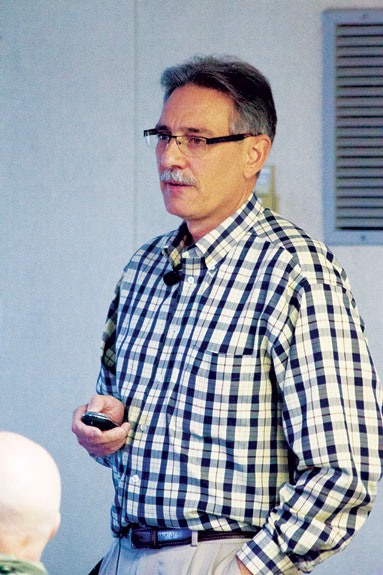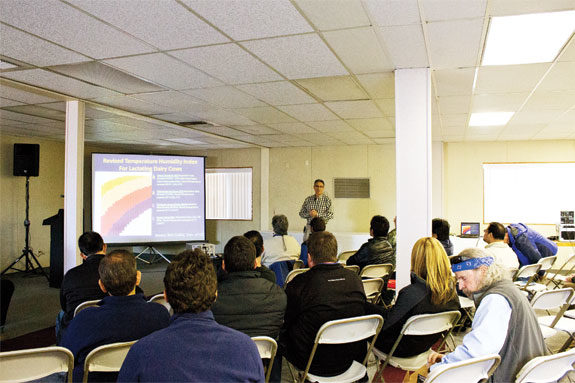Cow cooling, a topic not taken lightly by producers across the Southwest, was the topic of the noon dairy seminar on February 16 at World Ag Expo. John F. Smith, dairy extension specialist and professor at the University of Arizona, presented this topic, updating producers on current cow cooling research.
Smith began by discussing changes to the temperature humidity index (THI). He pointed out that one of his colleagues had recently published a new THI chart for lactating dairy cattle.
“What’s different is that we used to talk about the threshold being 72,” Smith said. “It has now been lowered to 68. With the new threshold, 70 would be considered moderate stress, 80 would be moderate to severe stress and severe stress at 90.”

Smith went on to discuss how heat stress impacts dairy cattle. He said that cows’ dry matter intake decreases and an increase in sweating and panting occurs to help maintain their core body temperature.
Also, less milk will be going into the tank and fewer cows will be bred due to heat stress. “She eats less and more of what she eats goes to maintaining a normal core body temperature,” Smith said.
He explained that, for heat-stressed cows that calve in the summer, peaks in production are less and sometimes don’t increase again until winter. “Anything we can do to reduce the dip in the cow’s milk production in the summer has a huge impact on milk production throughout the year,” Smith said.
Cooling cows
Smith described three non-evaporative cooling methods cows can use to cool themselves – convection, radiation and conduction. With convection, cool air is blown on the cow using fans. This cool air replaces the warm air near her skin.
Radiation is when the environment is cooler than the cow’s body temperature and she radiates her body heat off to the environment. Conduction is where a cow physically comes into contact with something much cooler than her body that pulls heat out of her.
He also discussed two ways in which cows use evaporative cooling – by evaporating moisture off her skin surface in the form of sweat or evaporating moisture out of her respiratory tract by increasing her respiration rate.
Smith explained that there are three ways to accomplish cow cooling – cool the cow, cool the air or a combination of both. A method used to cool the cow includes using a feedline soaker to wet the cow and having that water evaporate directly off the cow’s skin surface.
Smith pointed out that, while this does not change the air temperature, it does pull heat directly out of the cow. Using a combination of soakers and fans provides a way to cool the air and the cows.
Smith went on to discuss a trial conducted previously where they intentionally got cows hot to determine how fast they could cool them down. Respiration rates and body temperatures were logged in the trial.
Eight treatment groups were set up in which the control group had neither fans nor sprinklers. The second group had a sprinkler but no fan. The remaining groups of cows were soaked every five, 10 and 15 minutes with or without fans.
Findings indicated that fans alone did not reduce respiration rates, as hot air was being blown on cows that were already hot. As soaking frequency increased, respiration rates and body temperatures dropped. Every time a fan was added to the soaking, the respiration rate and body temperature was also reduced.
“The water is the magic,” Smith said. “If you only have the money for either a feedline soaker or a fan, go for the soaker.”
Cow cooling research
Smith explains that he conducted a trial on a commercial drylot dairy in Arizona last summer where the FlipFan system, developed by Schaefer Ventilation , was evaluated. This system was compared to a fixed-fan system with misters. The trial consisted of eight pens of cows with four pens per treatment.
He explains that, because the FlipFan system changes with sun angle and wind speed, it is always cooling the shaded area as opposed to always blowing west as would happen in a fixed-fan system, where the shade runs from north to south.
The trial also monitored the cows’ resting behavior. “In summary, the FlipFan system lowered core body temperature, increased rest time and lying bouts as compared to the fixed fans and misters,” Smith said.
Smith also explained that a couple of current research projects involve conductive cooling but, due to mixed results, more research would need to be conducted before seeing this as a cow cooling option.
“We’re putting a heat exchanger into the freestall bed and circulating cold water to physically cool the bed and create a temperature differential so that when the cow rests, we cool her by conduction,” Smith said.
Mechanically ventilated freestalls
Smith discussed different configurations of mechanically ventilated freestalls, such as tunnel ventilation and cross ventilation.
In these systems, the goal is to maintain a good wind speed on the cow’s skin surface in order to facilitate evaporating moisture. “As air speed is increased, heat loss goes up,” Smith said.
He also reviewed a few construction points for mechanically ventilated freestalls including the use of baffles, barn widths, bedding materials, ventilation system design and number of doors necessary for these barns.
Heat stress priorities
Smith concluded his presentation by discussing priorities when it comes to heat stress. Water availability was first on the list.
Other areas he discussed included having shade in the housing areas and holding pen, adding holding pen cooling and exit lane cooling, reducing time in the holding pen and having really good ventilation in the holding pen and freestall areas. PD
PHOTO
TOP RIGHT: Dr. John F. Smith began a recent seminar on cow cooling by discussing changes to the temperature humidity index (THI).
MIDDLE TOP RIGHT: He pointed out the new THI chart for lactating dairy cattle indicates cows may become stressed earlier than previously thought. Photos by PD staff.

Dario Martinez
Editor
Progressive Dairyman







